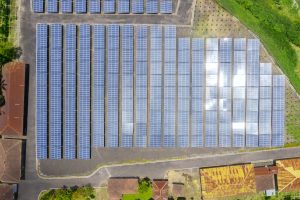With the recent release of its Comprehensive Investment and Policy Plan, Indonesia now has a roadmap for its Just Energy Transition Partnership (JETP). And the big headline figure has always been $20 billion in financing commitments from foreign partners in the United States, United Kingdom, Europe and Japan. While that figure is of course substantial, what actually matters is how the investment will be structured and implemented.
The JETP is promising to mobilize $20 billion in financing (mostly loans) which will be used to back private developers who want to enter the Indonesian market and build clean energy like solar, geothermal, and wind power. This figure is divided into two parts: $10 billion from governments and multilateral lenders, and $10 billion from the private sector at market rates.
For now, what we are interested in is that first $10 billion, which will come from governments and development banks in Japan, the U.S., and Europe. Some, but not all, of this financing will be concessional, meaning the borrower (Indonesia) is offered a lower interest rate or more attractive terms than what could be obtained in competitive capital markets.
The idea is that the initial $10 billion will be used to jump-start investment and demonstrate that Indonesia is a viable market for clean energy development. Once this proof of concept has been shown, the private sector will follow with an additional $10 billion or more in market rate financing and investments. So what do we know so far about this initial $10 billion?
The European Investment Bank has pledged a financing facility of just over $1 billion. France, through its development agency AFD, has pledged up to 500 million euros ($540 million) in concessional lending, and Germany has committed nearly $1.5 billion. Japan is mobilizing $1.7 billion of both concessional and non-concessional loans. Although many details still need to be worked out, it appears Japan and Europe are making relatively straightforward commitments to dispatch over $4.5 billion in financing, much of which will be on terms better than can be obtained on the open market.
When we get to the U.K. and the U.S., however, things become less straightforward. Both countries are offering sovereign guarantees that will allow Indonesia to increase its borrowing limit at the World Bank. The U.S., through the Development Finance Corporation (DFC), is also offering $1 billion in non-concessional financing. It comes with a caveat, however, which reads a bit like an admonishment: “DFC’s ability to provide investments ultimately remains a function of the volume of private sector-led projects that meet DFC’s financing, environmental, and social standards, and that seek financing from DFC; project developers can only proceed where host governments have provided the regulatory and enabling environment that supports private sector investment.”
What this means is that instead of directly pledging concessional financing or equity investment as other JETP partner countries are, the U.K. and U.S.’ primary commitment will be a credit guarantee allowing Indonesia to borrow an additional $2 billion from the World Bank over and above its current borrowing limit. In my personal opinion, this does not send the strongest of signals.
The DFC meanwhile will commit $1 billion of non-concessional financing, but Indonesia is expected to make pro-market reforms first that will enable and support more private sector investment. These reforms include overhauling state-owned electric utility PLN’s business model and procurement processes, raising retail electricity prices and shifting substantial market risk from private developers onto the state.
The long-term goal of the JETP is obviously to open Indonesia up for a big investment boom in solar led by the private sector, and this initial $10 billion is supposed to help pave the way. But if the U.S. really wants to take the lead in Indonesia’s clean energy transition, it could simply mobilize financing and investment without the expectation that Indonesia will make sweeping pro-market reforms first.
It’s worth remembering that the U.S. and its allies are not the only sources of financing for Indonesia’s clean energy transition. A geothermal subsidiary of state-owned oil and gas company Pertamina recently raised over $500 million on the domestic stock exchange by floating only a quarter of its equity. Indonesia’s state-owned banks are well capitalized and capable of mobilizing significant sums to finance clean energy projects.
If China enters Indonesia’s clean energy market in earnest, it will almost certainly not require major pro-market reforms in exchange for investment. The United Arab Emirates, which has no shortage of cash, is already in the market partnering with PLN to build utility-scale solar through its energy firm Masdar.
The JETP has a good basic idea, which is for the U.S., Japan, and European allies to lead the way on Indonesia’s clean energy transition. But when we look at the sums actually committed, and the conditions under which they are being offered, a couple billion dollars in concessional and non-concessional financing and credit guarantees designed to catalyze a big wave of market-rate debt and private investment is not the only path forward here. Indonesia has made it clear the country is open to investment from all sources, but it has to be on terms that are sufficiently attractive and appealing to domestic stakeholders, and not just to foreign developers, lenders, financial companies, and the DFC.

































